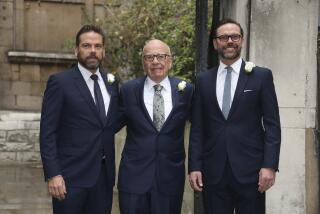Taking Firm Public Is Relatively Tough
- Share via
Stepping into the public glare of Wall Street is jarring for most family businesses, but the rewards have been worth the price for Channell Commercial Corp., a Temecula company that went public four years ago.
The money raised by selling almost half of the company to the public enabled the family patriarch and company chairman, William H. Channell Sr., 71, to cash out for millions of dollars without bankrupting the business. The family kept control of the company. And his son, the company president, got the cash to pursue his global growth strategy for the telecommunications equipment maker.
Sales have almost tripled to $121 million since the 1996 initial public offering.
On the downside, Wall Street rules limit how much of the family’s stock can be sold at once, and the family’s fortunes are closely tied to the market’s sometimes fickle moods. And, of course, the whole world can now second-guess the company’s every move.
“It’s not always pretty to have someone challenge you on income figures or decisions. But I picked my course,” said William H. Channell Jr., the 43-year-old president and chief operating officer.
The public scrutiny, the additional costs and, in some cases, the realization that the old guard may not be up to the challenge of running a public company can be a rude awakening for family businesses. It’s not the “easy money” it may seem to be, according to consultant Ken Anderson.
“They overlook the complexity, the regulatory stuff, the lack of privacy,” said Anderson, a director in the Los Angeles office of MyCFO, a financial planning company targeting high-income individuals.
When the older generation wants out, though, those are the issues many family businesses have to face.
For Channell Commercial, that day came in 1995 when the senior Channell told his son he was tired. A prolific inventor, as was his father (who founded the company), Channell Sr. had been running the family business for decades. If not ready to retire completely, he was ready to travel more and reap the fruits of his labors, his son said.
Three Choices to Raise Needed Funds
At that point, a family business has three basic options. It can decide to take the company public, sell it outright or find the funds internally, which is tough for many growing businesses.
“To divert corporate assets to pay for somebody’s retirement is a struggle” for many companies, said Anderson.
His parents left the decision up to him, said Channell Jr., who joined the company in 1979, the year he graduated from college and four years after his grandfather, company founder James Channell, died. Annual revenue was approximately $160,000.
Lacking the invention gene, he said, he gravitated toward sales and marketing early on. He positioned the company to sell to the fast-growing cable television industry, in addition to its longtime telephone company customers.
By 1995, sales had hit almost $40 million and Channell Jr. was building a business that could serve both broadband and telecommunications industries worldwide. He wasn’t ready to hand over the reins.
Looking back, Channell Jr. said his company’s growth mode had already forced it to put in place some of the professional management team and financial infrastructure required of a public company.
Still, there were hurdles and setbacks once he decided to take the company public.
One unexpected battle was with his father, whose hundreds of patents provided a healthy royalty income. Once the company was a public entity, the patents would be considered an asset of the corporation, as would the royalties. The father would receive an income from the company, but it was a difficult change for the longtime inventor and entrepreneur to accept.
The son had his own eye-openers. Potential investment bankers, he found, were less impressed with the company’s 20% annual growth rates than he expected. One told him he wouldn’t look at a company with less than twice that in annual growth.
Once it became public, the challenges continued. Board meetings no longer consisted of Channell and his parents. They added two outsiders when the company went public and recently added a third, an investment banker, to help with future acquisitions. After some initial forays with analysts, Channell hired a seasoned investor relations executive.
He still considers himself “a novice” at walking the tightrope required of a public-company executive when discussing the company’s future prospects, said Channell.
And the company recently hired a chief financial officer able to handle its now global operations.
Family business owners often ask Channell how to take their company public, in the hopes of a hefty payday for the senior generation. Most aren’t ready, said Channell, whose company has acquired three family businesses since it went public.
For smaller family businesses considering taking the IPO route, Channell usually offers several suggestions.
“I tell people if you have to change anyone in the room, it’s the finance guy. . . . It’s a mind-boggling job,” he said.
Good Accounting Firm Can Make a Difference
And he’s learned that Wall Street likes the books to be kept by well-known accounting firms. For those who can’t afford the services of the handful of recognized names, Channell has a tip. Use one of the smaller firms that do work for the big accounting firms. Their numbers are likely to be blessed by the big firms when it’s time to take the company public. They can also offer an experienced hand in the critical business of valuing a company correctly in preparation for selling shares to the public.
He also discovered that IPO deals are done through a tightknit web of relationships among lawyers, investment bankers and other professionals. Can’t afford a nameplate law firm to get access? Interview the mergers-and-acquisitions lawyers at smaller firms till you find one you like and rely on their network to help jump-start your efforts, he said.
And get used to being second-guessed. It’s a condition with which most business founders aren’t comfortable. And it’s why so many family businesses put off the difficult decisions involved in creating an exit strategy for the senior generation while preserving value for the children.
“Entrepreneurs are great at growing a business but horrible at selling it,” Channell said.
Cyndia Zwahlen can be reached at cyndia.zwahlen@latimes.com.
Has your family business solved a family business-related challenge? We’d like to hear about it. Write to us at: Family Business, Business Section, Los Angeles Times, 202 W. 1st St., Los Angeles, CA 90012 or send an e-mail to cyndia.zwahlen@latimes.com.
(BEGIN TEXT OF INFOBOX / INFOGRAPHIC)
Additional Resources
* “Financing Transitions: Managing Capital and Liduidity in the Family Business,” by Francois M. de Visscher, Craig E. Aronoff, John L. Ward (Family Enterprise Publishers, 1995)
For more information on the Family Business Leadership Series, call (800) 551-0633 or visit
https://www.efamilybusiness.com.
* “An Entrepreneur’s Guide to Going Public,” (Arthur Anderson, 1988). For a copy of this free booklet, call Sandy McNutt-Comrie at (213) 614-6762
More to Read
Inside the business of entertainment
The Wide Shot brings you news, analysis and insights on everything from streaming wars to production — and what it all means for the future.
You may occasionally receive promotional content from the Los Angeles Times.










